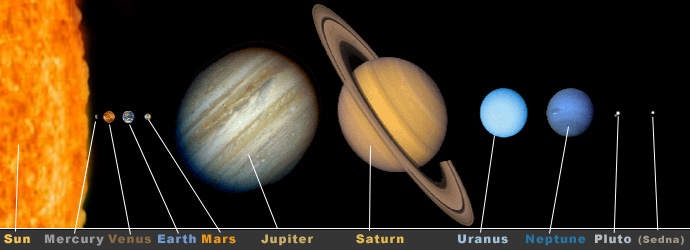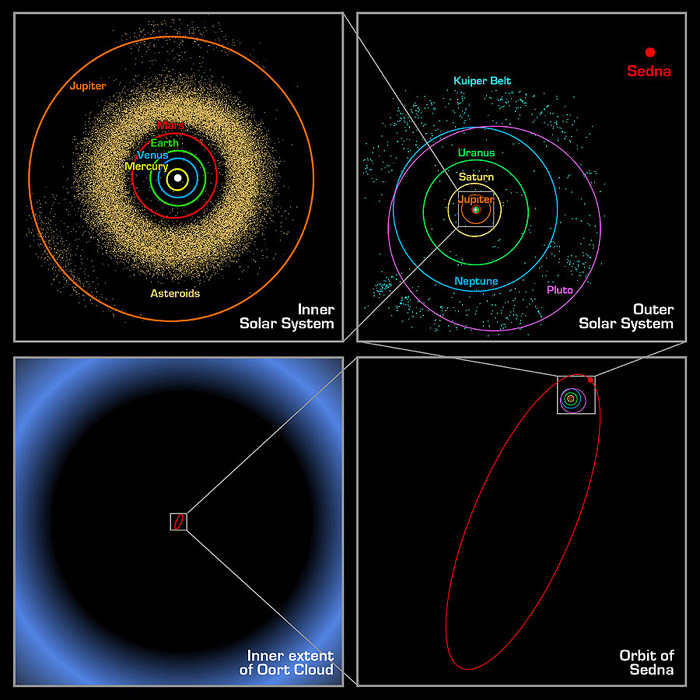|
| Earth & Moon | Our Solar System | Our Galaxy | The Universe | Historical Overview | Formulas | Links |
What is a solar system?
'Solar' refers to the Sun our host star. However, we use the phrase 'Solar system' for all kinds of star-systems, not
just our own. Our system consists of a star (Sun) and a number of planets.
History
The ancient greeks had a (for it's time) decent model of our solar system although not a correct one. Ptolemaos was
the philosopher who developed the famous Geocentric model with everything orbiting Earth in perfect circular orbits.
(Geocentric means the Earth was thought to be the center of the Universe as opposed to the Heliocentric model where the
Sun is placed at the center.) Another philosopher at the time (~260BC)presented a Heliocentric model. His
name was Aristarchus and as good as his idea was, he could not find a way to prove it. Not much happened until the
early 1540's when Nikolai Copernicus presented the revised Heliocentric model. He is generally recognized as the
father of the Heliocentric model, although others may beg to differ.
The 1540's though wasn't a very good time for scientist to propose theories that contradicted those of the Church at the
time (Geocentric view). It would take some more effort by Tycho Brahe and later Johannes Kepler to scientifically prove
that the Geocentric model was inaccurate. Kepler also realized that the planetary orbits weren't perfect circles at all,
but rather elliptical. The work of Galileo Galilei and perhaps most importantly, Isaac Newton finally brought an accurate
model of the Solar system and with the mathematics to prove it.
Later of course, the model was refined once more when Albert
Einstein's theory of relativity was presented. But in fact, for most simpler calculations, Kepler's laws of planetary
motion are still in use to this day.
Since the beginning of the last century, we have a very accurate model of our Solar system, but for a long time, we had
no idea if our system is one of a kind or if there are lot's of systems like ours out there. There were those who thought
that our type of system is very common and others who thought that it's not even certain other stars than our Sun have
planets at all. (Stupid, yes)
For the past couple of years, our methods for observing other stars have become better and these days we can actually
detect planets around other stars. As you read this, more than 100 planets have been found outside our own solar system.
(Take a look here.)
That may sound a lot, but we need to remember that our observational technique is in it's infancy. So far, we've only
detected those that were easy to spot (the big planets). In about 10-15 years we will have new tools at our disposal
and the number of detected planets will then likely grow extensively.
The members
Our solar system consists of numerous objects, no one knows exactly how many, simply because we have not yet examined
the outer regions of the system and we do not have the technology to detect objects below a certain size.
What we do know, is the number of planets and large moons. Our Sun is orbited by at least 9
planets and a bunch of smaller objects (Planetoids, Asteroids, comets etc).
Many of these planets have their own moons. As you know of course, the Earth has only one moon, but the much larger
Jupiter has over 60 moons.
Let's take a look at the larger members in the solar system.
As I mentioned on the previous page, it is impossible to show the true size and distance relationships between planets.
Below is a picture showing the Sun and the planets with approximate size relations, but the relative distances are of
course completely inaccurate.

|
Here are some facts about our solar system:
If you click on any of the bodies names, it will open up a new browser window with info from nineplanets.org
| Our solar system: Overview |
| Body |
Sun |
Mercury |
Venus |
Earth |
Mars |
Jupiter |
Saturn |
Uranus |
Neptune |
Pluto |
| Mass (Earth=1) |
333946 |
0.055 |
0.815 |
1 |
0.107 |
317.89 |
95.17 |
14.52 |
17.25 |
0.002 |
| Mass (metric tonnes) |
2*10e27 |
3.3*10e20 |
4.9*10e21 |
6*10e21 |
6.4*10e20 |
1.9*10e24 |
5.7*10e23 |
8.7*10e22 |
1*10e23 |
1.3*10e19 |
| Diameter (km) |
1392000 |
4878 |
12104 |
12756 |
6787 |
142800 |
119300 |
51120 |
49530 |
2270 |
| Volume (Earth=1) |
1303600 |
0.056 |
0.86 |
1 |
0.15 |
318.7 |
744 |
67 |
57 |
0.0055 |
| Density (Water=1) |
1.409 |
5.5 |
5.25 |
5.517 |
3.94 |
1.33 |
0.71 |
1.27 |
1.77 |
~2.07 |
| Axis Angle |
- |
0 |
178 |
23.5 |
24 |
3.1 |
26.7 |
97.5 |
29.9 |
~90(?) |
| Escape Velocity (km/s) |
617.5 |
4.3 |
10.36 |
11.18 |
5.03 |
60.22 |
32.26 |
22.5 |
23.9 |
1.22 |
| Surface Temp (°C) |
6000 |
-170/+350 |
+480 |
+22 |
-23 |
-150 |
-180 |
-210 |
-220 |
-215 |
| Albedo |
- |
0.06 |
0.76 |
0.36 |
0.16 |
0.43 |
0.61 |
0.35 |
0.35 |
0.6 |
| Orbital period |
- |
87days |
224days |
365days |
686days |
11.8years |
29.4years |
84years |
164.9years |
247.8years |
| Rotational period |
~26days |
58d, 15h, 30min |
243d, 3h, 50min |
1d |
24h, 37min |
9h, 55min |
10h, 39min |
17h, 12min |
16h, 7min |
6d, 9h, 17min |
| Distance from Sun (AU) |
- |
0.38 |
0.72 |
1 |
1.52 |
5.2 |
9.54 |
19.2 |
30.06 |
39.44 |
| Distance from Sun (M km) |
- |
58 |
108 |
150 |
228 |
778 |
1427 |
2870 |
4497 |
5900 |
| Number of moons |
- |
0 |
0 |
1 |
2 |
at least 60 |
at least 34 |
at least 21 |
at least 11 |
1 |
|
Click here to download a 3dsmax(v4) model of the Solar system. Scale is 1:1000000000. This is a simple model only
displaying the relative size between orbits and the size of the bodies. A more advanced (+animated) model might become available in the future.
|
| Major moons in our solar system |
| Body |
Luna (The Moon) |
Callisto |
Europa |
Ganymede |
Io |
Titan |
Triton |
| Orbiting: |
Earth |
Jupiter |
Jupiter |
Jupiter |
Jupiter |
Saturn |
Neptune |
| Orbit from host planet (km) |
384,000 |
1,883,000 |
670,900 |
1,070,000 |
422,000 |
1,221,830 |
354,760 |
| Orbital period |
27d 7h (Siderial) |
16d 17h |
3d 13h |
7d 4h |
1d 18h |
11d 20h |
5d 21h |
| Diameter (km) |
3476 |
4806 |
3138 |
5262 |
3630 |
5150 |
2700 |
| Mass (Metric tonnes) |
7.35e19 |
1.08e20 |
4.8e19 |
1.48e20 |
8.93e19 |
1.35e20 |
2.14e19 |
As you can see in the table above, some of the moons are actually bigger than some of the planets. Ganymede and Titan are
both larger than our innermost planet, Mercury. And there are no less than 7 moons in our solar system bigger than planet Pluto.
Most of the moons in our system are fairly "boring" rocky bodies, but there are a few that are very interesting indeed.
Scientists believe that Europa may have liquid water under its icy surface. This would also mean that Europa may
be the best place to look for present life outside Earth. Io is also an interesting place with its active volcanoes. And then
there is of course Saturn's Large moon Titan which is still being observed by the Cassini orbiter. Titan is the only moon in
our solar system with a thick atmosphere.
The outer limits
In 2002, a large body was detected outside Pluto's orbit. This has been dubbed Quaoar and is roughly 1,200km in diameter. Then in 2003, another major body was
discovered in far reaches of our solar system. This body has been named Sedna (although the name may be changed at a later date). It's size has not been precisely
determined yet but it is thought that the upper limit is about 1770km in diameter (Pluto is 2270km and our Moon is 3476km). Sedna may be smaller than that but not larger.
Below is an image provided by NASA. It shows the orbit of Sedna relative to the rest of the solar system. Note the extremely elliptical shape of the orbit. The highly
elongated orbit means that Sedna's distance from the Sun varies greatly depending on where in it's orbit it is at the time of measurement.

Here is some technical data for these two so called Kuiper Belt objects:
| Kuiper Belt Object: |
Quaoar |
Sedna |
| Av. Distance from Sun |
~43AU |
~509AU |
| Orbital period |
286 years |
11487 years |
| Diameter |
~1200km |
Min ~1200km, Max ~1800km |
|


